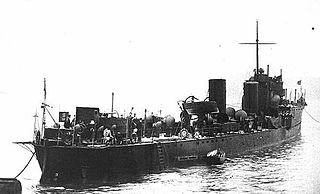
HMS Derwent was a Hawthorn Leslie-type River-class destroyer ordered by the Royal Navy under the 1901 – 1902 Naval Estimates. Named after the River Derwent in central England, she was the second ship to carry this name.

HMS Waveney was a Hawthorn Leslie-type River-class destroyer ordered by the Royal Navy under the 1902–1903 Naval Estimates. Named after the River Waveney in eastern England, she was the first ship of the Royal Navy to carry this name.

HMS Boyne was a Hawthorn Leslie type River-class destroyer ordered by the Royal Navy under the 1903 – 1904 Naval Estimates. Named after the River Boyne in Ireland, the site of a British military victory in 1689, she was the fifth ship to carry this name since it was introduced in 1692 for a two deck ship-of-the-line.

HMS Doon was a Hawthorn Leslie type River-class destroyer ordered by the Royal Navy under the 1903 – 1904 Naval Estimates. Named after the River Doon in western Scotland, she was the first ship to carry this name in the Royal Navy.
HMS Test was a Laird-type River-class destroyer purchased by the Royal Navy under the 1908–1909 Naval Estimates in December 1909. Named after the River Test in southern England by the city of Southampton, she was the first ship to carry this name in the Royal Navy.
HMS Stour was a Laird-type River-class destroyer purchased by the Royal Navy under the 1908 – 1909 Naval Estimates in December 1909. Named after the River Stour in West Central England near the city of Birmingham, she was the first ship to carry this name in the Royal Navy.
HMS Ouse was a Laird type River-class destroyer ordered by the Royal Navy under the 1903 – 1904 Naval Estimates. Named after the River Ouse in north east England near the city of York, she was the first ship to carry this name in the Royal Navy.

HMS Arun was a Laird Type River-class destroyer ordered by the Royal Navy under the 1902–1903 Naval Estimates. Named after the River Arun in southern England she was the first ship to carry this name in the Royal Navy.
HMS Foyle was a Laird-type River-class destroyer ordered by the Royal Navy under the 1902–1903 Naval Estimates. Named after the River Foyle in Ireland, she was the first ship to carry this name in the Royal Navy.

HMS Itchen was a Laird-type River-class destroyer ordered by the Royal Navy under the 1901–1902 Naval Estimates. Named after the River Itchen in southern England near Southampton, she was the first ship to carry this name in the Royal Navy.
HMS Liffey was a Laird-type River-class destroyer ordered by the Royal Navy under the 1903 – 1904 Naval Estimates. Named after the River Liffey flowing through Dublin, she was the third and final ship to carry this name since it was introduced in 1813 for a 50-gun 4th rate sold in 1827.
HMS Ness was a White Type River-class destroyer ordered by the Royal Navy under the 1903 – 1904 Naval Estimates. Named after the River Ness in northern Scotland, flowing through Inverness, she was the first ship to carry this name in the Royal Navy.
HMS Nith was a White Type River Class Destroyer ordered by the Royal Navy under the 1903–1904 Naval Estimates. Named after the River Nith in southern Scotland, on the West Coast, she was the first ship to carry this name in the Royal Navy.

HMS Teviot was a Yarrow type River Class Destroyer ordered by the Royal Navy under the 1902 – 1903 Naval Estimates. Named after the River Teviot in southern Scotland near the border with England, she was the first ship to carry this name in the Royal Navy. She served during World War 1, primarily on anti-submarine duty in the Channel, and was sold for breaking up in 1919.

HMS Usk was a Yarrow type River Class destroyer ordered by the Royal Navy under the 1901 – 1902 Naval Estimates. Named after the River Usk in Wales flowing through Newport, she was the first ship to carry this name in the Royal Navy.

HMS Erne was a Palmer Type River Class Destroyer ordered by the Royal Navy under the 1901 – 1902 Naval Estimates. Named after the River Erne in Ireland, she was the third ship to carry this name since it was introduced in 1813 for a 20-gun brig sold in 1819.

HMS Ettrick was a River-class destroyer ordered by the Royal Navy under the 1901 – 1902 Naval Estimates. Named after Ettrick Water in the Scottish Borders area south of Edinburgh, she was the first ship to carry this name in the Royal Navy. She was launched in 1903 and served during World War I. She was torpedoed by UC-61 in 1917.
HMS Cherwell was a Palmer Type River-class destroyer ordered by the Royal Navy under the 1902 – 1903 Naval Estimates. Named after the River Cherwell in south central England near Oxford, she was the first ship to carry this name in the Royal Navy.
HMS Jed was a Thornycroft type River-class destroyer ordered by the Royal Navy under the 1903 – 1904 Naval Estimates. Named after the River Jed in southern Scotland, she was the second ship to carry this name since it was introduced in 1814 for a 26-gun sixth rate ship sold in 1833.
HMS Ure was a Palmer Type River Class Destroyer ordered by the Royal Navy under the 1903 – 1904 Naval Estimates. Named after the River Ure in Yorkshire, England, she was the first ship to carry this name in the Royal Navy.









